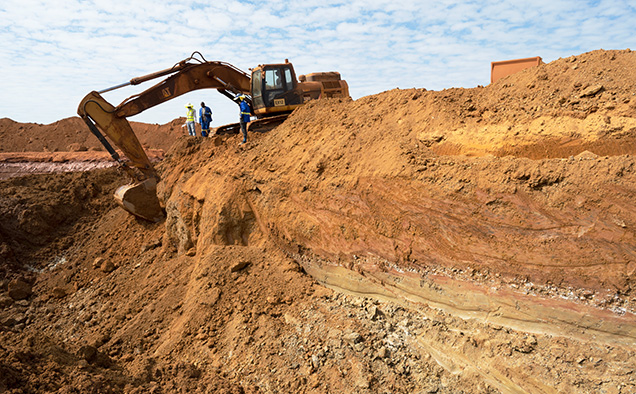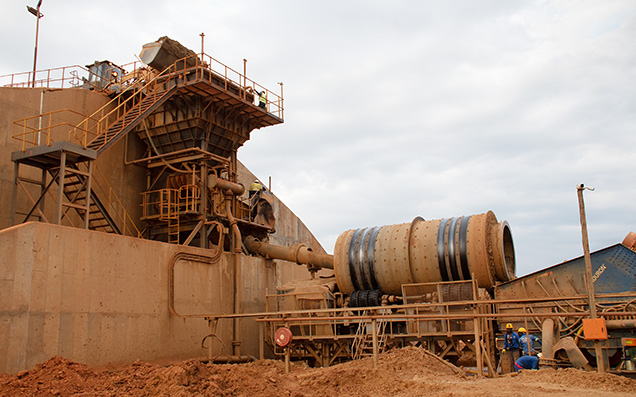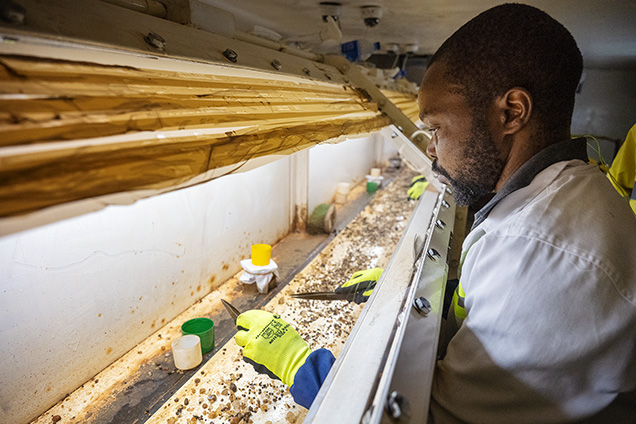Update from Mozambique’s Ruby Mines

Mozambican rubies have revolutionized the dynamics of the ruby trade since their debut on the global gem scene in 2009. GIA has been following the evolution of the deposits around Montepuez in the Cabo Delgado Province of northern Mozambique since the very beginning (see W. Vertriest and S. Saeseaw, “A decade of ruby from Mozambique: A review,” Summer 2019 G&G, pp. 162–183). In August 2022, a GIA field gemology team visited the mining area to document the current state of mining and to collect samples for future studies.
In less than a decade, the balance has shifted from an informal environment dominated by artisanal miners and foreign buyers to a situation that is mostly under the control of large-scale miners who bring these rubies directly to the global market.
There are currently three of these major operations working in the area east of Montepuez.
- Montepuez Ruby Mining (MRM): A partnership between Gemfields and local partner Mwiriti that has been mining rubies since 2012. Gemfields also mines Zambian emeralds at the Kagem mine.
- Fura Gems: This company has been involved in Mozambican ruby mining since 2019. Some of their concessions were previously worked by Mustang Resources. Fura is also actively mining Colombian emerald and Australian sapphire.
- GemRock: Owned by luxury jewelry brand DiaColor, this operation has been active on the ground since 2019.
In terms of geological formation, the ruby mineralization in the Montepuez area is not yet fully understood. The gems are generally described as amphibole-related corundum since the associated rocks are rich in amphibole. This mineral also dominates the inclusion scene of these gems.
While some primary mineralization is known and these ruby-bearing bodies are areas of interest for the mining companies, the rubies are seldom mined from the host rock. Nearly all of the mining activity is focused on the secondary deposits. These weathered gravel layers are rich in rubies and referred to locally as camada. This type of material is easy to mine, and the value of the ruby found here is higher than that in the primary deposits. The original host rock may contain higher volumes, but the majority of this corundum tends to be of very low grade. The exploration strategies of the mining companies focus heavily on identifying the extent, thickness, and distribution of the secondary gravels throughout their respective concessions. Understanding the geological formation of the corundum in this geological setting is a continuing process. Exploration teams are actively delineating and characterizing the ore bodies that hold the primary mineralization.
All three large-scale operations extract these ruby-rich gravels by stripping the overburden with excavators. This exposes the camada, which is dug up and stockpiled near the wash plants (figure 1). Local variations of the gravel layers can provide additional challenges. In some areas the sediment cover is less than 50 cm thick, which means the shallow gravel layer contains an abundance of roots, branches, and other organic material, making it harder to process further down the line. In other areas, the gravels are buried over 15 m deep, requiring serious effort and planning to strip the overburden. The ruby-rich layers themselves can vary from 10 to 150 cm; in some cases, multiple layers are present. The main one is always lying directly on the (extremely weathered) basement rock, which often consists of amphibolites, gneisses, and occasional felsic pegmatite veins.

While washing the rubies out of the gravel sounds very straightforward, this is a complex engineering process that requires careful monitoring and control. The gravels are unsorted, with quartz boulders up to 30 cm in diameter, but can also have a significant clay content. Processing them is no easy task and requires many steps of separating by size as well as various techniques to break up sediment clusters and concentrate the ore. Sizing is routine, but the other steps require considerable effort. At all of the large mining operations, logwashers, rotating trommels, and high-pressure water jets are used to break up clay clumps (figure 2). Concentration of the gravels (i.e., removal of the unwanted minerals) focuses on separating based on the specific gravities of the components of the sediment. Ruby is relatively dense compared to most other minerals such as feldspar and quartz. The most convenient method is using a pulsating jig where the waterlogged gravels move across a screen with barriers while getting pushed up vertically. This allows lighter materials to wash over the jig while denser minerals are concentrated at the bottom. While simple, this technique has its limitations, and several of the mines have progressed to more advanced techniques that allow for more precise separation and/or higher capacity, such as dense media separators and rotating pans in which a slurry with a precisely controlled density is used to separate heavier mineral fractions.
All of these techniques require large volumes of water. Plant operators assume that every metric ton of gravel processed requires 1000 liters of clear water. This water consumption was a decisive factor for development of the wash plant. For instance, a nearby river can serve as a cheap and constant supply of water, while boreholes are a much more costly alternative. As such, considerable effort is put into recycling water using settling ponds, cyclones, and flocculants. This allows much of the water, sometimes up to 90%, to be reused in the cleaning process.
With three large-scale mines operating in the area, the volumes of gravel processed are immense. The combined washing capacity of the three mines is more than 500 metric tons per hour.

The final product coming out of the wash plant is an intensely concentrated mix of heavy minerals enriched in ruby, though considerable portions of garnet, iron oxides, and other minerals are still present. Initially simple techniques such as manual sorting were used to handpick the rubies from this mix. As these operations grew, however, more advanced technology has been applied. Optical sorting devices are able to recognize rubies by their fluorescence and separate them from the mix. Most mines use these devices nowadays, often with manual control of the rejects since the machines are not flawless. In a final step, the mix of rubies is graded based on clarity, color, and size. Some mines perform this detailed and specialized task at company headquarters, while others do so at the mine. During the final stages of concentrating the rubies, security procedures become increasingly strict. Automatic sorting and gloveboxes (figure 3) are used to avoid contact with the rubies. The final grading, which must be done manually by experienced specialists, is heavily supervised in secured spaces. This is one reason why some companies prefer to do this at their headquarters.
The further development and growing importance of these large-scale mining operations has also brought changes to the artisanal mining communities. These garimpeiros mined 100% of Mozambique’s rubies in the first years after the discovery in 2009. Only in 2014 did the first rubies from large-scale mining reach the international market, through an auction hosted by MRM. Not all of these small-scale miners are local; many traveled from other provinces in Mozambique or even from neighboring countries such as Tanzania. In recent years, the importance of the garimpeiro in Mozambique’s ruby market has been in decline. Legal codes were adjusted to make unlicensed mining a crime, allowing government officials to intervene with the artisanal mining activities that took place on the licenses of the large companies. As compensation, the government created areas designadas that were assigned to the artisanal miners. However, these are often small and nearly barren. At the moment, these areas cover an area of four square kilometers. The mining licenses secured by the large-scale mining companies cover over 2,000 square kilometers. Conflicts over mining rights have created considerable tension between established powers and the local communities. Some of these disputes are only now coming to light or are just beginning to be felt.
But the most drastic impact on the artisanal mining community has probably been the sanctions against the foreign buyers in the neighboring towns. Ruby buyers, mainly from Asia, have worked from offices near Montepuez to buy directly from the garimpeiros since 2008–2009, but their numbers have been drastically reduced in recent years. This has almost completely eliminated the main clientele for the artisanal ruby miners. During GIA’s visit in 2016, huge numbers of garimpeiros (tens of thousands of them) could be seen working and traveling throughout all the mining concessions east of Montepuez. During GIA’s recent 10-day expedition in August 2022, only 37 artisanal miners were seen in the same area. Most of the artisanal activity has moved farther east toward the city of Chiure, where the garimpeiros are mining more recent river sediments that are rich in rubies. Many have returned to their home villages, while some of the locals have found employment with the large mining companies.
The Cabo Delgado Province is currently experiencing social and political turmoil. Religious extremist groups under the name Ahlu-Sunna wa al Jama’a have been growing more violent. This has forced many people to abandon their villages and relocate to the southern reaches of the provinces, where the mines are located. One company reported that the number of people residing on their mining license increased from 1,500 to more than 20,000 in less than one year.
The local political structure also lacks the strength to successfully empower the local communities. All large-scale miners pay significant royalties and taxes to Mozambique’s central government. Unfortunately, many of these funds fail to reach the historically underprivileged communities surrounding the mines in the northern Cabo Delgado Province. This only amplifies social unrest. Many local projects have been set up by the large companies as part of their own corporate social responsibility programs, focusing on a sustainable food supply, transportation, and healthcare.
The last five years have brought dramatic change to ruby mining around Montepuez. Nowadays the dominant players are the larger operations and no longer the garimpeiro community with their associated trading network. These large-scale miners have immensely upgraded and professionalized their operations since their initial exploration and early mining phases. They have integrated more sophisticated techniques in both the gravel processing and the sorting. Larger fleets of machinery and fine-tuned wash plants allow huge volumes of ruby ore to be handled. This has resulted in a more stable ruby supply to the international markets.
However, the situation on the ground remains unstable, with social unrest growing in the wider areas where the ruby mining is happening. Only time will tell how this situation will evolve.
.jpg)


